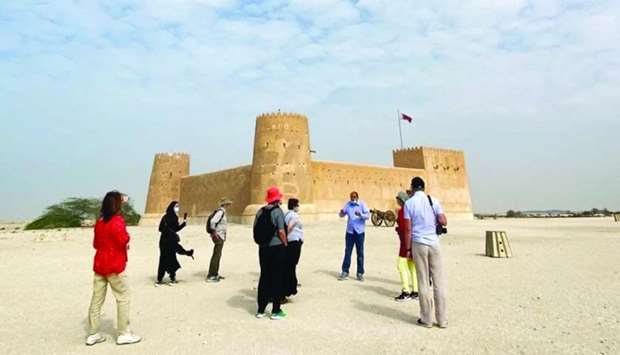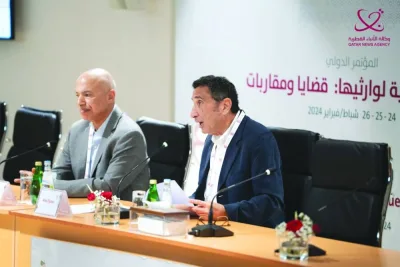Atharna, a Qatar Museums (QM) programme launched in December last year, received a positive response from Culture Pass members who had the chance to take part in its first two activities.
Atharna kicked off on January 2 with a tour to Al Zubarah, allowing participants to explore the 60 hectare archaeological (and Unesco World Heritage) site, the site museum, and the Al Zubarah Fort.

“We put local communities, of a wide range of ages, in touch with their past, reminding them of the lifestyle the Qatari ancestors had, via curated tours to historical sites around Qatar, designed exclusively to you. Atharna is your gateway to discover the heritage of Qatar, from early medieval settlements, to 19th century forts, villages, towers and mosques,” QM posted on its Instagram page.
Atharna, which forms part of “an initiative to introduce the wider community to Qatar’s archaeological history”, provides an opportunity for Culture Pass members to visit historical sites across the country through curated tours.
The second part of the programme included a workshop on ‘Experimental Archaeology: How to make prehistoric stone tools’, presented by QM’s Archaeology Department director Faisal al-Naimi at the National Museum of Qatar on January 9.
Apart from presenting the process of making chipped stone tools and their function, an experimental part of the workshop also engaged participants in a basic knapping training and required them to produce their first stone tool.
A similar workshop for Culture Pass Plus and Family Members was organised by QM at the Archaeology Storage, Fahd Bin Ali Palace in November 2019. The session introduced them to the prehistoric stone tools of Qatar and briefed them about the different raw materials used in making these tools.
Another QM tour titled “Mysterious Signs and Symbols: Jassasiya Rock Art Site” is set on January 16 between 11am and 1pm, which will take participants to Al Jassasiya. It is described as “the most impressive of a dozen rock-carving sites in Qatar.”
First discovered in 1957, QM noted that the site was “thoroughly studied in 1974, when 874 limestone carved single figures and compositions were catalogued. They consist mainly of cup marks in various arrangements, including rows, rosettes and stars, but also of carvings such as boats, footprints and enigmatic symbols and signs. It’s believed that the cup marks were used for playing ancient board games, such as ‘mancala’, known as Al Haloosa or Al Huwaila in Qatar.”
QM has advised Culture Pass members to register early and take part in a pottery workshop on ‘Unveiling Archaeological Sources’ between 11am and 1pm on January 23.

QM holds a workshop on how to make prehistoric stone tools at NMoQ recently as part of its Atharna programme
“We put local communities, of a wide range of ages, in touch with their past, reminding them of the lifestyle the Qatari ancestors had, via curated tours to historical sites around Qatar, designed exclusively to you. Atharna is your gateway to discover the heritage of Qatar, from early medieval settlements, to 19th century forts, villages, towers and mosques,” QM posted on its Instagram page.
Atharna, which forms part of “an initiative to introduce the wider community to Qatar’s archaeological history”, provides an opportunity for Culture Pass members to visit historical sites across the country through curated tours.
The second part of the programme included a workshop on ‘Experimental Archaeology: How to make prehistoric stone tools’, presented by QM’s Archaeology Department director Faisal al-Naimi at the National Museum of Qatar on January 9.
Apart from presenting the process of making chipped stone tools and their function, an experimental part of the workshop also engaged participants in a basic knapping training and required them to produce their first stone tool.
A similar workshop for Culture Pass Plus and Family Members was organised by QM at the Archaeology Storage, Fahd Bin Ali Palace in November 2019. The session introduced them to the prehistoric stone tools of Qatar and briefed them about the different raw materials used in making these tools.
Another QM tour titled “Mysterious Signs and Symbols: Jassasiya Rock Art Site” is set on January 16 between 11am and 1pm, which will take participants to Al Jassasiya. It is described as “the most impressive of a dozen rock-carving sites in Qatar.”
First discovered in 1957, QM noted that the site was “thoroughly studied in 1974, when 874 limestone carved single figures and compositions were catalogued. They consist mainly of cup marks in various arrangements, including rows, rosettes and stars, but also of carvings such as boats, footprints and enigmatic symbols and signs. It’s believed that the cup marks were used for playing ancient board games, such as ‘mancala’, known as Al Haloosa or Al Huwaila in Qatar.”
QM has advised Culture Pass members to register early and take part in a pottery workshop on ‘Unveiling Archaeological Sources’ between 11am and 1pm on January 23.




